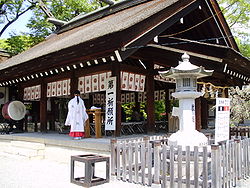- Ōtori taisha
-
Ōtori taisha
大鳥神社
Inside Ōtori taisha Information Dedicated to Prince Yamato Takeru Address Osaka-fu, Sakai-shi, Nishi-ku, Otorikita-Machi 1-1-2 Phone 072-262-0040 Website Homepage Ōtori taisha (大鳥神社), also known as Ōtori Grand Shrine, is a Shinto shrine in Nishi-ku ward in the city of Sakai, Osaka, Japan.
Contents
History
The legend of the origin of the shrine states that the hero Yamatotakeru-no-Mikoto, who turned into a white swan upon his death, last stopped at the future site of the Otori Taisha. It is said that the people nearby built the shrine in order to worship white swans[1]. The prince Yamato Takeru (originally prince Ousu), son of Emperor Keiko of the Yamato Dynasty, is enshrined here. The prince was praised for his bravery in battle and was given the name Yamato Takeru, or The Brave of Yamato, by his enemy as he died [2]. Ōtori Taisha is believed to be in the service of the gods of literature and martial arts, and it was said that warriors often visited in ancient times.
Ōtori was designated as the chief Shinto shrine (ichinomiya) for the former Izumi province. [3]
From 1871 through 1946, Ōtori was officially designated one of the Kanpei-taisha (官幣大社), meaning that it stood in the first rank among government supported shrines.
Grounds
The shrine's grounds, which extend over 50,000 square meters, contain a quiet forest known as Chigusa-no-mori because of the seemingly endless variety of tree species which can be found there. The shrine is also known for its iris garden, which features over 100,000 flowers. There is a monument in the shrine on which a tanka poem was inscribed by Tessai Tomioka.
Notable Architecture
The main building, Ōtori zukuri, is built in one of the oldest architectural styles used for Japanese shrines.[4] This building burned down in 1905, but was rebuilt in 1909.
Visiting
There are no set hours and admission is free. To reach Ōtori taisha, take the JR Hanwa Line and get off at Otori Station.
Gallery
See also
Notes
External links
Shinto shrine Shinto architecture Buildings - chōzuya or temizuya
- haiden
- heiden
- hokora
- honden / shinden / shōden
- kagura-den
- massha
- sessha
Architectonic elements Styles - hirairi-zukuri
- tsumairi-zukuri
- gongen-zukuri
- hachiman-zukuri
- hiyoshi-zukuri
- irimoya-zukuri
- ishi-no-ma-zukuri
- kasuga-zukuri
- kibitsu-zukuri
- misedana-zukuri
- nagare-zukuri
- ōtori-zukuri
- owari-zukuri
- ryōnagare-zukuri
- shinmei-zukuri
- sumiyoshi-zukuri
- taisha-zukuri
Others Implements Main kami Staff Head shrines1 - Fushimi Inari Taisha
- Usa Hachiman-gū
- Ise Grand Shrine
- Dazaifu Tenman-gū
- Munakata Taisha
- Suwa Taisha
- Hiyoshi Taisha
- Kumano Nachi Taisha
- Tsushima Shrine
- Yasaka Shrine
Miscellaneous 1 (in order of the size of the shrine network they head)
Coordinates: 34°32′13″N 135°27′39″E / 34.53694°N 135.46083°E
Categories:- Shinto shrines in Osaka Prefecture
Wikimedia Foundation. 2010.



